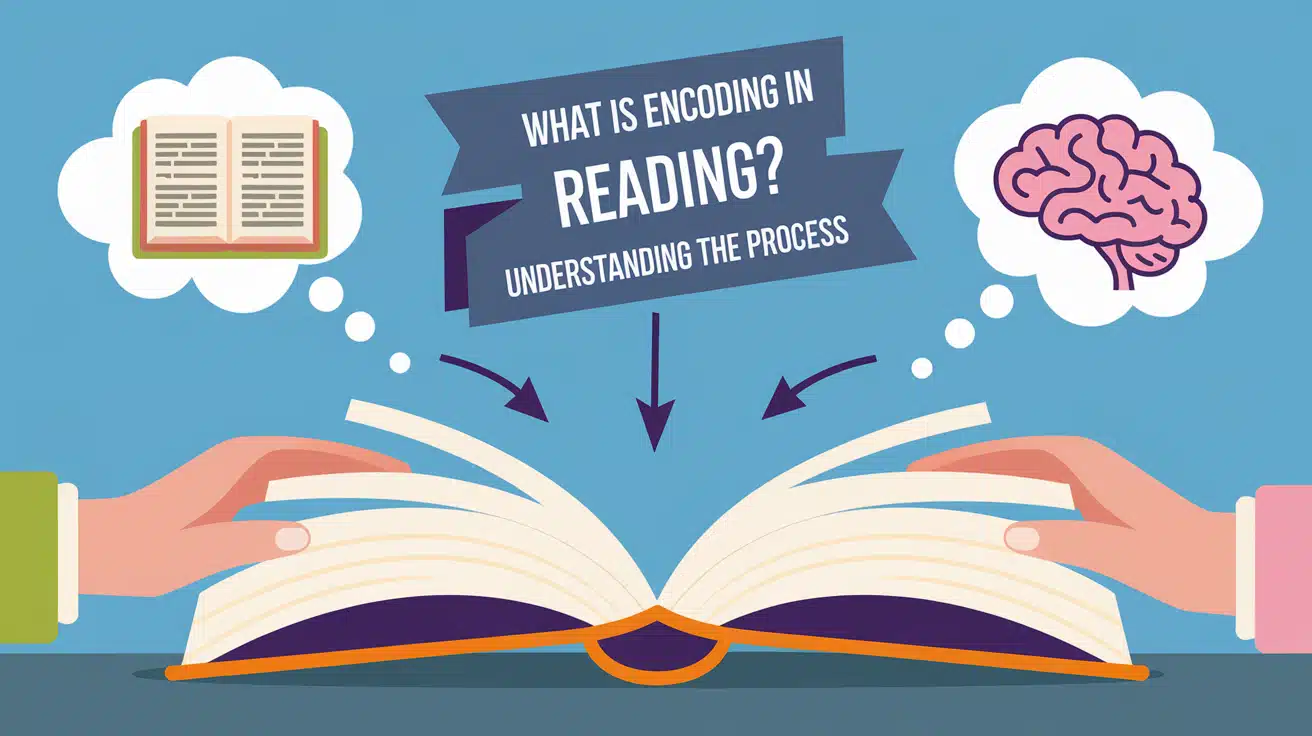Ever wonder why some children struggle with reading? The answer often lies in encoding and decoding skills.
What is encoding in reading? Encoding happens when we turn our thoughts into written words. It’s like translating our ideas into a code others can understand. When children write “cat,” they’re encoding their mental image of a furry pet into letters.
Decoding is the opposite process. It occurs when we see written words and turn them back into meaning. When kids see “c-a-t” and recognize it means a four-legged animal that purrs, they’re decoding.
These skills work together like two sides of a coin. Strong readers need both abilities to succeed. Without good encoding and decoding, reading and writing become difficult challenges.
In this blog, we’ll learn about what encoding in reading is and everything related to it.
What is Encoding?
Encoding is the process of turning sounds into written symbols. When a child writes or spells words, they are encoding. This skill forms the foundation of writing development.
In simple terms, encoding is like translating spoken language into a written code. When children learn to write “dog,” they must connect the sounds /d/, /o/, and /g/ to the correct letters.
This requires them to break down words into individual sounds and match those sounds with the right letters or letter patterns.
Strong encoding skills depend on phonics knowledge. Phonics teaches the relationship between sounds and letters. To encode properly, children must understand that the sound /b/ is written with the letter “b.”
Phonemic awareness is equally important. This skill helps children identify and manipulate the individual sounds in words. Before writing “stop,” a child needs to hear all four sounds: /s/, /t/, /o/, and /p/.
How to Check Your Child’s Encoding Skills
Early detection of encoding problems helps prevent later writing difficulties.
- Look for invented spelling in younger children. Writing “kat” for “cat” shows they understand sound-letter connections.
- Notice if they struggle to hear all sounds in words. Missing letters may indicate weak phonemic awareness.
- Watch how they approach unfamiliar words. Do they sound them out?
- Pay attention to common spelling patterns. Can they write words with “sh” or “ch” correctly?
- Compare their spoken vocabulary to what they can write. A big gap might suggest encoding difficulties.
What is Decoding?
Decoding is the process of translating written words into sounds and meaning. When a child sees the word “cat” and pronounces it correctly, they’re using decoding skills. This ability forms the foundation of reading development.
At its core, decoding involves breaking down written words into individual sounds and then blending those sounds together. Children must recognize that “c-a-t” represents the sounds /k/, /a/, and /t/, which together make “cat.”
While encoding transforms thoughts into written symbols, decoding works in the opposite direction, converting written symbols into meaningful language. These processes are two sides of the same page.
Strong readers need both skills to succeed. When children understand how sounds map to letters (encoding), they also gain insight into how letters represent sounds (decoding).
Tips to Improve Decoding Skills
With consistent practice and support, most children can develop strong decoding skills, which can lead to fluent reading and comprehension.
- Use decodable texts with words that follow patterns the child has learned.
- Teach common letter patterns and word families like “-at” (cat, bat, rat).
- Play sound-blending games where you pronounce individual sounds and the child blends them.
- Read aloud daily, occasionally running your finger under words to show sound-symbol connections.
- Teach sight words alongside phonics instruction.
The Relationship Between Encoding and Decoding
Encoding and decoding work as complementary processes in literacy development.
They both rely on a solid understanding of the sound-symbol relationship in language. When children learn to encode, they strengthen pathways that also support decoding, and vice versa.
For example, a child who practices writing “stop” must segment the word into individual sounds (/s/, /t/, /o/, /p/) and match them to letters. This same phonemic awareness and letter-sound knowledge helps when they later need to decode “stop” while reading.
Research shows that instruction addressing both skills leads to stronger overall literacy development than focusing on either skill separately.
Students with difficulties in one area often struggle in the other, showing their interconnected nature.
The strongest readers and writers typically show proficiency in both encoding and decoding processes.
Encoding vs. Decoding – Key Differences
The way our brains process written language works in two main directions. When we write, we use encoding skills to turn our thoughts into text. When we read, we use decoding skills to understand what’s on the page.
These two processes work together but involve different mental tasks, as shown in this helpful comparison:
| Encoding | Decoding |
|---|---|
| Converting thoughts/sounds into written symbols | Converting written symbols into sounds/meaning |
| Speaking/thinking → Writing | Reading → Understanding |
| Breaking words into sounds, then choosing letters to represent those sounds | Recognizing letters, connecting them to sounds, and then blending sounds into words |
| Writing and spelling | Reading and pronunciation |
| The child thinks of a dog and writes “D-O-G.” | The child sees “DOG” and reads it as “dog.” |
| Hearing “cat” and spelling it as “C-A-T” | Seeing “C-A-T” and pronouncing it as “cat” |
| Phonemic awareness, letter knowledge, spelling rules | Letter recognition, phonics knowledge, and blending ability |
| Spelling errors, omitting sounds in writing | Slow reading, mispronunciations, guessing words |
| Writing dictated words, independent writing samples | Reading tests, oral reading fluency measures |
Understanding this two-way street of language processing helps parents and teachers spot where a child might need extra help. Some kids may excel at reading (decoding) but struggle with spelling (encoding), or the other way around.
Both skills need practice and support as children learn to read and write.
How Encoding and Decoding Affect Skills

Effects on Reading Comprehension
These fundamental abilities directly impact how effectively people navigate daily life. When decoding becomes automatic, readers can focus their mental energy on understanding what they read rather than figuring out individual words.
A child who struggles with decoding might correctly sound out, “The dog ran fast,” but they use so much mental effort to do so that they can’t understand the meaning. In contrast, fluent decoders can immediately access the meaning while reading, allowing them to make predictions about what might happen next in a story.
Connect new information to what they already know and visualize scenes and characters.
Draw inferences about implied information and also monitor their understanding
Impact on Writing Fluency
Strong encoding skills free up brain power during writing.
When spelling becomes easy and automatic, writers can focus on organizing their thoughts clearly instead of struggling to spell each word.
Writers who spell well can create different types of sentences that flow nicely together, making their writing more interesting to read. They have the mental space to fully explain their ideas, adding helpful details and examples.
Also, these writers can spend time fixing and improving their work, making word choices better and sentences smoother without getting stuck on basic spelling problems.
The result is writing that gets the message across clearly and shows thoughtful ideas.
Overcoming Common Challenges
Many kids face problems when learning to read and write. With encoding, some children can’t hear all the sounds in words.
They often miss middle or ending sounds. Many kids mix up letters like b/d or p/q when writing, and some spell the same word differently each time they write it.
Others spell words exactly as they sound and can’t remember special spelling patterns. Words with silent letters, like “knife” or “write,” are extra difficult.
With decoding, some children read very slowly, even when they get the words right. This makes it hard to understand what they read. Some guess words after seeing just the first letter. Others can say each sound but can’t blend them into words.
To help with these problems, break tasks into small steps, give quick, gentle feedback when mistakes happen, and use pictures and charts to help visual learners.
Build confidence by celebrating small wins. Practice often, but keep sessions short. Focus on your child’s specific problems. Remember, all children learn at different speeds.
Tips to Improve Encoding and Decoding Skills
There are many simple ways to help children get better at encoding and decoding.
For Encoding,
- Try breaking words into sounds before writing them.
- Use all the senses by finger spelling or writing in sand.
- Practice word families like “-at” words (cat, hat, bat) to build confidence.
- Create word walls to help kids remember common words.
- Set aside time each day for writing practice.
- Play fun spelling games like Scrabble Junior.
- Use letter tiles to build and change words.
For decoding,
- Read with your child every day and point to words as you read.
- Use books that have words following patterns they’ve learned.
- Practice blending sounds together.
- Try word ladders, where you change one letter at a time to make new words.
- Use flashcards to practice letter sounds.
- Read a sentence and have your child repeat it.
- Teach kids to break long words into parts.
- Practice common words like “the” and “and” until they become automatic.
Conclusion
Learning to read and write depends on encoding and decoding skills. These two processes work together like partners. Both parents and teachers are important in helping children develop these skills.
If you notice your child having trouble with encoding or decoding early on, you can get them the help they need before bigger problems develop. Every child learns these skills at their own pace. The key is to be patient and consistent.
Start by testing your child’s encoding and decoding skills using the tips we shared earlier. Connect with your child’s teacher to learn what specific skills they’re working on in class and ask how you can support this learning at home.
Don’t forget to bookmark this page and share it with other parents and teachers who might find it helpful!




